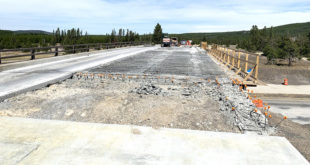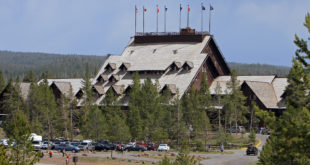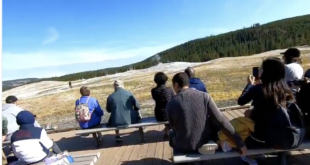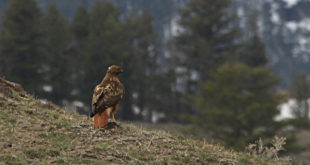Despite the lack of geothermal excitement, West Thumb is one of the must-see attractions of the park for its unpredictable nature and scenic locale on the shores of an amazing alpine lake. Unlike attractions such as Fountain Paint Pots or Norris Geyser Basin, there are not long lines of people milling around, providing you with a more relaxing experience. It’s a great place to take a relaxing stroll amidst the bubbling thermal water. None of the features are exactly legendary (save one), but they offer just as much as any other basin in the park. Some of the deeper pools, such as Black Pool and Abyss Pool, are just as, if not more, beautiful as Morning Glory. Some of the basin even extends into the neighboring lake, sometimes underwater until August. West Thumb also features Fishing Cone, which sits just ten or so feet away from the boardwalk in the middle of the lake.
Another great aspect of the basin is its location. Not only does it sit right next to Yellowstone Lake with a clear view of the mountains, it also sits between two of the biggest lodging hubs in the park: Old Faithful and Lake Hotel. Driving to West Thumb from Lake offers spectacular views of the lake, while the drive from Old Faithful takes you through a rugged mountain pass as well as over the Continental Divide. In addition, West Thumb is only a mile away from Grant Village, and a great stopping point if you’re driving to Grand Teton National Park as well.

Why West Thumb?
Those mapping the Park in the earliest explorations saw Yellowstone Lake as a hand, with the fingers pointed down. The area was projected as a thumb, but later exploration showed that what explorers assumed was an extension of Yellowstone Lake was really a standalone body of water. It was named Delusion Lake, but the West Thumb moniker stuck.
The West Thumb Geyser Basin is located directly east of West Thumb Junction. It is a very basic stop in terms of facilities: picnic tables tucked in the woods, rustic pit restrooms, phone and a building serving as a Yellowstone Association bookstore in the summer and a warming house in the winter. Definitely take a peek inside: the building dates back to 1925 and originally served as a Ranger Station. Many of you will remember more facilities in the past at West Thumb: Being a major intersection, services like a gas station and store were located there. However, because of concern over proximity to the geyser basin, the services were moved in 1989 once Grant Village was established. The concern ended up being visionary: the geyser basin may not appear to be too active, but looks can be deceiving, as those of us entering in recent years discovered as we dodged new hotspots in the parking lot!
West Thumb Bay may look like it’s been part of Yellowstone Lake forever, but it’s a relatively recent addition to the landscape: It was formed 170,000 or so years ago after an explosion created a crater. Water rushed in, and more water entered the lake and bay from geysers and hot springs on the shore.
Getting to them and the lake is easy. The figure-eight boardwalk slopes downward to Yellowstone Lake from the parking lot, and some steps on the north side of the half-mile walk (farthest from the parking lot) are the only barriers to a very mild walk.

Loop the Loop
Like most Yellowstone visitors, we are creatures of habit, so we tend to take the same route every time we visit the West Thumb Geyser Basin: We veer to the right, loop around to the lake and cut down the middle on the way back. We’d suggest you do the same; the following list of highlights in order will make sense.
The first thermal feature on this route, Thumb Paint Pots, were once called Mud Puffs, according to old guidebooks, and we admit we like the name better. Truth is, they’re not much to look at anymore; they’re like the bottle of Champagne left overnight and discovered on New Year’s Day, sad and almost-flat reminders of the good times in the past. Skip ahead to Seismograph and Bluebell pools, which despite the proximity are usually completely different in terms of colors and water temperatures.
Continue walking past Lakeside Spring and Venting Pool – which can be spectacular in springtime, less so as the season goes along and the water levels recede – to Lakeshore Geyser, one of the three geysers now under water at least part of the year. All three are traditional geysers with traditional cones, and they tell us something important: that for a very long time the water levels in Yellowstone Lake were lower, as sinter cones like these do not form underwater. (Indeed, tests show that Yellowstone Lake is higher now than in the past, putting these waterside features underwater, at least through June and July. Two theories for this: a rise of the Yellowstone caldera and global warming.)
You’ll then hit Fishing Cone, progenitor of one of great Yellowstone tall tales. Early visitors told of a place where you could stand at the short of a high alpine lake, cast and easily catch trout, and then cook the trout still on the line in a boiling pool. The place actually existed in the form of Fishing Cone, and indeed the 1870 Washburn Expedition confirmed it what would end up being known as Chowder Pot or Fish Pot. Early visitors to Fishing Cone were issued an apron and a cook’s hat – the better for pictures – and many anglers were brave enough to give the process a shot. We’re guessing the fish were pretty much inedible (there’s a reason why you gut fish before cooking them; add to the general mess the mineral from the pool, and you’re likely to end up with an unappealing hunk of something), and after several anglers were injured in the pursuit of trout, the practice was halted.
Head up the boardwalk to Black Pool and King Geyser, two features that are far less impressive now than in the past. Black Pool was indeed black at one point, but eruptions and higher temperatures in 1991 ended up killing the dark-colored bacteria that gave the pool its name. Now, having said that, the more recent blue and green colors in the pool are quite lovely and worth a look. King Geyser, too, was once more active, but these days eruptions are very rare.
The 1991-1992 period was a time of change in West Thumb Geyser Basin: Besides the changes to Black Pool, seismic shifts first caused Abyss Pool to violently erupt after 80 years of dormancy, then caused it to recede to a quiet state. It’s still worth a look: the green-blue pool is still quite lovely.
Head back up the hill and go to the overlook to your left. From here you’ll see Twin Geysers, once the most active thermal features in the area but now just sporadically erupting. The middle boardwalk will take you past several interesting pools to your left, including Blue Funnel Pool and Perforated Pool, which occasionally erupt as geysers. They are also quite unpredictable: you never know when something will shift and a formerly quiet spring becomes a nice-sized geyser. To the right are the Painted Pools (also known as the Mimulus Pools). From here you can head back to the former Ranger Station or your car.
All in all, West Thumb is one of the simpler, but nonetheless rewarding, basins in the Park, and a great stopping point if you’re traveling through Yellowstone. Because the colors in the pools change from month to month and year to year, you’ll never have the same exact experience there as the last time you visited.
Other Trails
Most folks hit West Thumb and tour the geyser field, blissfully unaware of other trails in the area. There are two trails heading out of the West Thumb parking lot, and both are worth a look.
A hidden gem accessible from the West Thumb parking lot is the Yellowstone Lake Overlook Trail, a two-mile loop that takes you to the top of Savage Hill for some great views of Yellowstone Lake. (Why Savage Hill? Concessionaire employees – well before the days of Xanterra – have called themselves Savages for ages. These employees dubbed the hill Savage Hill, and the name stuck.) The hike will take you through burned-out forest and some laid-back thermal features before reaching the top of the hill and the lovely view of the vista. Warning: this isn’t the easiest of hikes, as it rises some 400 feet from bottom to top. On a clear day, though, it’s worth the effort.
The second hike is shorter – less than two miles total – and much less strenuous: the Duck Lake Trail takes you to Duck Lake, a small body of water created by an explosion crater. The first part of the hike – some half-mile long – takes you to a view of the lake and is easy, while the second part of the hike – another third of a mile – is more strenuous, as it requiring hiking up and down the edge of the crater. You can choose exactly how much work you want to put into the hike. (Many of you have seen Duck Lake many times and not realized it. As you approach West Thumb Junction from the west – i.e., Old Faithful Village – there’s a descent on the final stretch where Yellowstone Lake first appears in a rather breathtaking fashion right after a hairpin curve. Far below you is a lake. That’s Duck Lake.)
Both trails are accessible from the West Thumb parking lot: the Yellowstone Lake Overlook Trail trailhead is in the southwest corner of the lot, while the Duck Lake Trail trailhead is accessible from the northwest corner: you’ll need to cross the Grand Loop Road to reach it.
Page 3 image courtesy of National Park Service.
We’ve also set up a free Twitter account so you can receive updates on the device of your choice.
 Yellowstone Insider Your Complete Guide to America's First National Park
Yellowstone Insider Your Complete Guide to America's First National Park





